National symbols of Wales
The national symbols of Wales include a diversity of official and unofficial images and other symbols.
| Part of a series on the |
| Culture of Wales |
|---|
.svg.png.webp) |
| History |
| People |
| Religion |
| Art |
|
Flags
.svg.png.webp) |
The Flag of Wales incorporates the red dragon, now a popular Welsh symbol, along with the Tudor colours of green and white. It was used by Henry VII at the battle of Bosworth in 1485 after which it was carried in state to St. Paul's Cathedral. The red dragon was then included in the Tudor royal arms to signify their Welsh descent. It was officially recognised as the Welsh national flag in 1959. The British Union Flag incorporates the flags of Scotland, Ireland and England but does not have any Welsh representation. Technically, however, it is represented by the flag of England due to the Laws in Wales act of 1535 which annexed Wales following the 13th century conquest. |
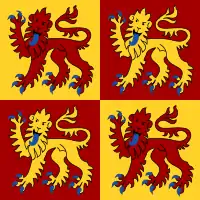 |
The flag of the Princely House of Aberffraw, blazoned Quarterly or and gules, four lions passant guardant two and two counterchanged langued and armed Azure.[1] The flag was first associated with Llywelyn the Great, who received the fealty of all other Welsh lords at the Council of Aberdyfi in 1216, becoming de jure Prince of Wales, according to historian Dr. John Davies. From the 11th century onwards, the Aberffraw family claimed primacy as princes of Wales as the senior descendants of Rhodri the Great, and included Owain Gwynedd, who was known as princeps Wallensium (Prince of the Welsh), and Llywelyn ap Gruffudd. |
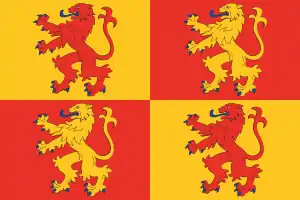 |
The flag of Owain Glyndŵr, Prince of Wales, which combined the flags of Powys and Deheubarth, blazoned Quarterly or and gules, four lions rampant two and two counterchanged. The red lion on a yellow field represented Powys, and the yellow lion on a red field represented Deheubarth. Owain was the senior heir of both Powys and Deheubarth. The flag harkened back to the Aberffraw flag, linking Owain's rule with the Aberffraw princes of Wales in an effort to legitimize his rule. It is currently in use by the National Eisteddfod of Wales, Cymdeithas yr Iaith Gymraeg and widely amongst pro-independence groups. |
 |
The Flag of Saint David, sometimes used as an alternative to the national flag, is flown on St David's Day. |
Heraldry
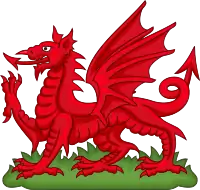 |
The Red Dragon, part of the national flag design, is also a popular Welsh symbol. The oldest recorded use of the dragon to symbolise Wales is from the Historia Brittonum, written around 820, but it is popularly supposed to have been the battle standard of King Arthur and other ancient Brittonic leaders. This myth is likely to have originated from the tale of Merlin's vision of a Red (The Native Britons) and a White (The Anglo-Saxon settlers) dragon battling, with the red dragon being victorious. Following the annexation of Wales (Pura Wallia) and the Marches (Marchia Wallia) by England, the red dragon was used as a supporter in the English monarch's coat of arms. The red dragon is often seen as a shorthand for all things Welsh, being used by many Welsh public and private institutions (e.g.: The Welsh Government, Visit Wales, numerous local authorities including Blaenau Gwent, Cardiff, Carmarthenshire, Rhondda Cynon Taf, and sports bodies, including the Sport Wales National Centre, the Football Association of Wales, Dragons and London Welsh RFC. The red dragon also features on the coat of arms (crest) of Cumbria: "On the right is a red dragon - a reference to the red Dragons of Appleby the ancient county town of Westmorland; also it is heraldically related to the red wyverns of Carlisle and symbolises the connection, going back to Celtic times, between Cumbria and Cambria (Wales)". The Somerset Council in 1911 opted for a red dragon, reportedly making reference to the tradition that King Arthur had a red dragon; a recognition moreover, of the county's ancient Celtic heritage. |
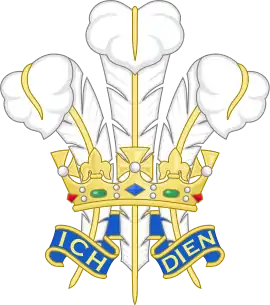 |
The Prince of Wales's feathers, the heraldic badge of the Prince of Wales is sometimes adapted by Welsh bodies for use in Wales. The symbolism is explained on the article for Edward, the Black Prince, who was the first Prince of Wales to bear the emblem; see also John, King of Bohemia. The Welsh Rugby Union uses such a design for its own badge. Many British two pence coins in circulation today bear the Prince of Wales' feathers to represent Wales. |
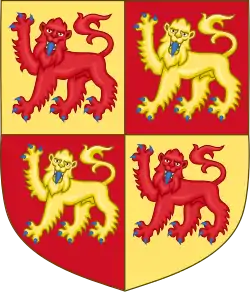 |
The Coat of Arms of the Principality of Wales which are the historic arms of the Kingdom of Gwynedd are used by Charles, Prince of Wales in his personal standard. They are also the basis for the Royal Badge of Wales issued in 2008 for the use of the National Assembly for Wales. |
 |
The Royal Badge of Wales, which uses the historic arms of the Kingdom of Gwynedd, is the de facto coat of arms of Wales. The badge was introduced in 2008 and is accordingly a heraldic badge, rather than a coat of arms. |
Plants and animals
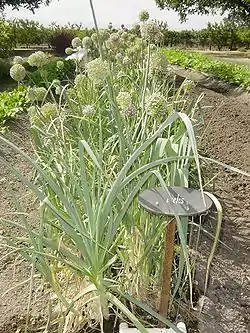 |
The leek is the national emblem of Wales.[2] According to legend the patron saint of Wales, Saint David, ordered his Welsh soldiers to identify themselves by wearing the leek on their helmets in an ancient battle against the Saxons that took place in a leek field. The origin is also dramatized in Shakespeare's Henry V when the Welsh captain Fluellen remarked that Welsh soldiers fought a battle "in a garden where leeks did grow" for England in the time of Edward III. It is still worn on St David's Day |
_-_25.jpg.webp) |
The daffodil is the national flower worn on St David's Day (1 March) in Wales. The daffodil may be known as Welsh: cenhinen Bedr (Saint Peter's leek) |
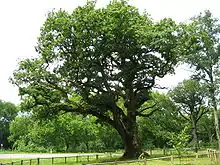 |
The Sessile Oak, also called the Welsh Oak is the national tree of Wales |
.jpg.webp) |
The red kite is sometimes named as the national symbol of wildlife in Wales.[3] |
Other symbols
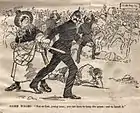 |
Dame Wales (or Mam Cymru), as a National personification, as depicted by Joseph Morewood Staniforth symbolising the maternal voice of the Welsh 'mam' |
- Patriotic anthems for "the land of Song" include the national anthem "Hen Wlad fy Nhadau" (English: Land of My Fathers), "Men of Harlech", the national hymn "Cwm Rhondda", (English: Bread of heaven) "Delilah", "Calon Lan" and "Sosban Fach".
- Traditional Welsh costume, such as the Welsh hat and bedgown, is now recognised as the national dress of Wales. It was originally worn by rural women throughout Europe and Britain, it survived longest in Wales up until the 1880s. Today it is worn by women at events such as Royal visits, by choirs, at church and chapel, for photographs and occasionally at eisteddfodau. It was first worn by girls as a celebration on Saint David's Day just before the First World War.
References
- The arms and flag have four squares alternating in gold and red (representing the Royal House of Aberffraw and iron, or Mars the god of War). Each square has a lion of the opposite colour. The lion is looking at the observer and has 3 paws on the ground and one raised high in the air ("passant guardant"); the tongue is stuck-out ("langued") and the claws outstretched claws ("armed"). Both are blue ("Azur". This represents primacy in Wales).
- Ben Johnson. "The Leek - National emblem of the Welsh". Historic UK. Retrieved 3 March 2017.
- The RSPB: Red kite voted Wales' Favourite Bird